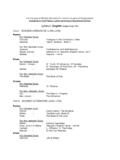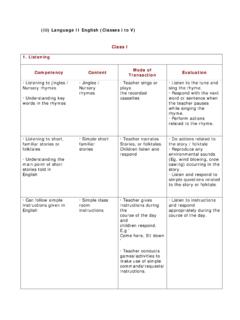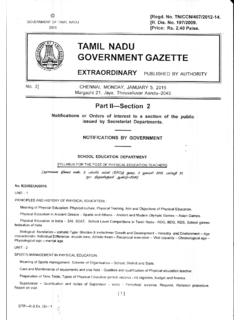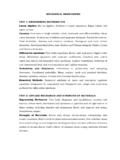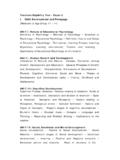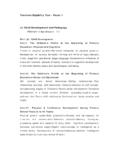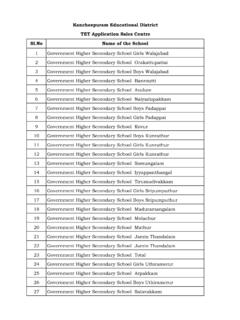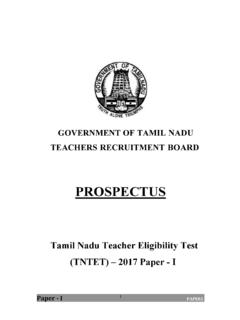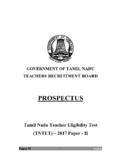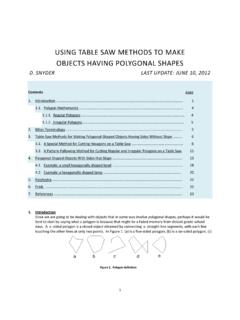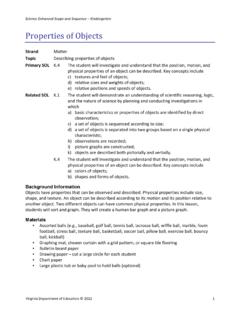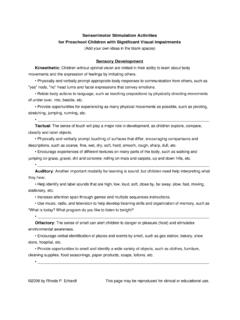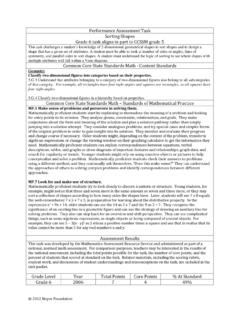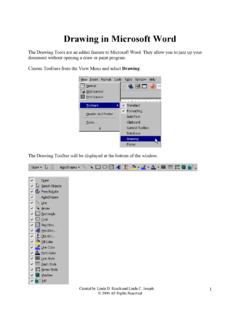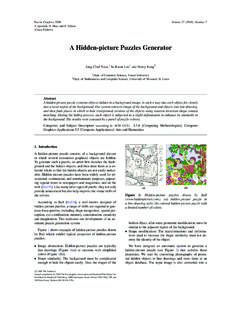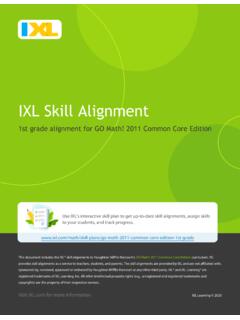Transcription of TET Paper 1 Mathematics - t n
1 (iv) Mathematics Class I. Content Expected Learning Mode of Topic Outcomes Transaction I. Shapes Introduction to To build a sense of spatial Observing and spatial orientation orientation. things Figures Introduction to To understand spatial Sorting shapes in real relationship. objects objects and its Understand the meaning Telling stories attributes of and use appropriate Simulation Introduction to spatial vocabulary exercises elementary Ex. Top, Bottom, On, Drawing shapes Under, Inside, Outside, activities Sorting object Above, Below, Near, Far, Tracing groups into Before, After activities shapes To correlate concrete Colouring things to their shapes Sensory To Learn vocabulary activities related to nature of shapes Ex.
2 Shapes, flat, round, corner, edge, surface, plain, long & short. To know elementary names of shapes like square, circle, oval, rectangle, triangle To observe and describe objects from the surroundings having different sizes and shapes like pebbles, boxes, balls, pipes, bottle caps, pencil, eraser. To collect objects from the surrounding sort and classify on the basis of shapes, and other observable properties. II. Numbers Numbers from 1 To count the number of Singing songs to 9 objects in a collection. Counting, Concept of Zero In two similar grouping, Numbers from 10 collection of objects taking away to 20 To match object through Comparing Addition (of single one to one correspondence writing digit numbers To recognize and speaks Drawing Content Expected Learning Mode of Topic Outcomes Transaction whose sum is less numbers from 1 to 9.)
3 Playing games than 20) To make the group of Relating to life Subtraction of objects according to a situation numbers without given number. Visualizing conversion To use numbers from 1 to Numbers from 20 9 in counting and to 99 comparison. Place value as To understand the concept Tens and of nothing give the Ones symbol zero to represent it. To read and write numerals from 1 to 9. To learn addition using real objects up to a sum of 18. To use the symbol +' to represent addition. To learn vocabularies like total, together, altogether etc.
4 , to denote addition. To understand subtraction as taking away using real objects. To understand subtracting as canceling using pictures. To use vocabularies like difference, take away, less etc., to denote subtraction. To approach zero through the subtraction pattern (such as 5 1 = 4, 5 2 =. 3, 5 5 = 0). To approach zero through real life situation (such as there are 5 chocolates all of them were eaten up, how many remaining?). To learn sense of numbers up to 20. To read and write numbers from 10 to 20. To make the group of objects according to a given number.
5 To group objects into a Content Expected Learning Mode of Topic Outcomes Transaction group of 'tens' and ones'. To learn intuitively build a notion of place value. To count the number of tens and ones in a given number. To represent numbers tens and ones through pictures. To learn numbers by rote from 21 to 99. To read and writes numerals for Twenty-one to Ninety nine. To read numbers represented as groups of tens and ones 21 to 99. To identify the predecessor and successor up to 99. To identify numbers in between Ex: 24, _ _ , 26. To skip count by twos forward to backward up to Ninety-nine.
6 To skip count by threes forward to backward up to Ninety-nine. To add two single digit numbers up to sum of 10. mentally. III. Introduction to To build notion of length, Observing Measureme Length, Mass, mass, and volume. Comparing nts Volume To build intuitive notion of Visualizing comparisons of Conversation Comparison of lengths/masses/sizes of activity Objects Using different objects. Guessing Length, Mass, To describe lengths using activity Volume through terms like near, far, thin, Play way Non Standard thick, longer/taller, activity Units shorter, high, and low.
7 : Sequencing similarly terms like lighter activity Time and heavier To measure lengths of Earlier Later, object that use in non- Shorter, Longer standard units. To establish an intuitive Content Expected Learning Mode of Topic Outcomes Transaction Money need for standardization. To distinguish between events occurring in time using terms -earlier and later. To get the qualitative feel for long & short duration, of school days v/s holidays. To narrate the sequence of events in a day. To Able to identify common currency notes and coins.
8 (up to rupees 20). IV. Patterns Patterns in To identify the patterns in Observing Shapes shapes Drawing Patterns in To make pattern through Following the Numbers shapes. number To identify the patterns in sequence numbers. Colouring (using elementary examples). V. Study of Handling Simple To collect, represent and Observing Data Data (shapes interpret simple data such Counting and numbers) as Mode of transport to Tabulating School, Favorite TV Surveying Organizing simple program, Numbers of data (shape and brothers and sisters etc., numbers).
9 Class - II. Content Expected Learning Mode of Topic Outcomes Transaction I. Shapes Identifying the 2-D and 3-D Shapes Day to day life and Figures Dimension of situation shapes in everyday To identify 2-D shapes viz., examples. object rectangle, square, triangle, Review circle by their names. exercises. Introduction to To describe intuitively the Practical spatial orientation properties of these 2-D examples. Content Expected Learning Mode of Topic Outcomes Transaction Introduction to shapes. Practical shapes of objects To describe qualitatively examples.
10 In real life and its the properties of these 2-D. attributes shapes. Introduction to To observe objects in the elementary environment and gets an shapes intuitive feel for their Sorting object geometrical attributes. groups into To sort similar shapes of shapes. different sizes. To draw straight line shapes by Paper folding and other such simple aids. To make patterns and shapes with straight and curved lines. To learn names such as cuboid, cylinder, cone, sphere and recognize objects. To draw the 2-D outlines of 3-D objects. To describe intuitively the properties of these 2-D.
